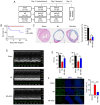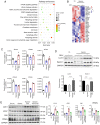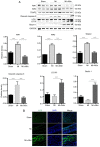S‑allyl‑cysteine sulfoxide (alliin) alleviates myocardial infarction by modulating cardiomyocyte necroptosis and autophagy
- PMID: 31573046
- PMCID: PMC6777694
- DOI: 10.3892/ijmm.2019.4351
S‑allyl‑cysteine sulfoxide (alliin) alleviates myocardial infarction by modulating cardiomyocyte necroptosis and autophagy
Abstract
S‑allyl‑cysteine sulfoxide (alliin) is the main organosulfur component of garlic and its preparations. The present study aimed to examine the protective effect of alliin on cardiac function and the underlying mechanism in a mouse model of myocardial infarction (MI). Notably, alliin treatment preserved heart function, attenuated the area of infarction in the myocardium of mice and reduced lesions in the myocardium, including cardiomyocyte fibrosis and death. Further mechanistic experiments revealed that alliin inhibited necroptosis but promoted autophagy in vitro and in vivo. Cell viability assays showed that alliin dose‑dependently reduced the necroptotic index and inhibited the expression of necroptosis‑related receptor‑interacting protein 1, receptor‑interacting protein 3 and tumor necrosis factor receptor‑associated factor 2, whereas the levels of Beclin 1 and microtubule‑associated protein 1 light chain 3, which are associated with autophagy, exhibited an opposite trend upon treatment with alliin. In addition, the level of peroxisome proliferator‑activated receptor γ was increased by alliin. Collectively, these findings demonstrate that alliin has the potential to protect cardiomyocytes from necroptosis following MI and that this protective effect occurs via the enhancement of autophagy.
Figures




Similar articles
-
Targeting necroptosis as therapeutic potential in chronic myocardial infarction.J Biomed Sci. 2021 Apr 9;28(1):25. doi: 10.1186/s12929-021-00722-w. J Biomed Sci. 2021. PMID: 33836761 Free PMC article. Review.
-
Alliin alleviates myocardial ischemia-reperfusion injury by promoting autophagy.Biochem Biophys Res Commun. 2019 Apr 30;512(2):236-243. doi: 10.1016/j.bbrc.2019.03.046. Epub 2019 Mar 15. Biochem Biophys Res Commun. 2019. PMID: 30885435
-
Metformin mediates cardioprotection against aging-induced ischemic necroptosis.Aging Cell. 2020 Feb;19(2):e13096. doi: 10.1111/acel.13096. Epub 2020 Jan 14. Aging Cell. 2020. PMID: 31944526 Free PMC article.
-
RIP3, a kinase promoting necroptotic cell death, mediates adverse remodelling after myocardial infarction.Cardiovasc Res. 2014 Jul 15;103(2):206-16. doi: 10.1093/cvr/cvu146. Epub 2014 Jun 11. Cardiovasc Res. 2014. PMID: 24920296
-
MicroRNA-325-3p protects the heart after myocardial infarction by inhibiting RIPK3 and programmed necrosis in mice.BMC Mol Biol. 2019 Jun 27;20(1):17. doi: 10.1186/s12867-019-0133-z. BMC Mol Biol. 2019. PMID: 31248365 Free PMC article.
Cited by
-
Targeting necroptosis as therapeutic potential in chronic myocardial infarction.J Biomed Sci. 2021 Apr 9;28(1):25. doi: 10.1186/s12929-021-00722-w. J Biomed Sci. 2021. PMID: 33836761 Free PMC article. Review.
-
PANoptosis: Novel insight into regulated cell death and its potential role in cardiovascular diseases (Review).Int J Mol Med. 2024 Sep;54(3):74. doi: 10.3892/ijmm.2024.5398. Epub 2024 Jul 4. Int J Mol Med. 2024. PMID: 38963054 Free PMC article. Review.
-
Receptor Interacting Protein Kinases 1/3: The Potential Therapeutic Target for Cardiovascular Inflammatory Diseases.Front Pharmacol. 2021 Nov 18;12:762334. doi: 10.3389/fphar.2021.762334. eCollection 2021. Front Pharmacol. 2021. PMID: 34867386 Free PMC article. Review.
-
Potential applications of components of aged garlic extract in mitigating pro-inflammatory gene expression linked to human diseases (Review).Exp Ther Med. 2025 May 13;30(1):134. doi: 10.3892/etm.2025.12884. eCollection 2025 Jul. Exp Ther Med. 2025. PMID: 40432842 Free PMC article. Review.
-
Targeting the pathways of regulated necrosis: a potential strategy for alleviation of cardio-cerebrovascular injury.Cell Mol Life Sci. 2021 Jan;78(1):63-78. doi: 10.1007/s00018-020-03587-8. Epub 2020 Jun 28. Cell Mol Life Sci. 2021. PMID: 32596778 Free PMC article. Review.
References
MeSH terms
Substances
LinkOut - more resources
Full Text Sources
Other Literature Sources
Medical
Research Materials

